
What Is Cart Abandonment? Tips To Recover Lost Sales
You’ve crafted the perfect eCommerce website and stocked it with amazing products or services. Your marketing efforts are driving traffic like never before.
But just as you’re about to celebrate, you notice something troubling. Shoppers are abandoning their carts at an alarming rate. It’s like watching potential sales slip through your fingers, leaving you frustrated and wondering what went wrong.
Welcome to the world of cart abandonment. Worry not, as with the right strategies, you can reduce this effect and even turn abandoned carts into revenue opportunities. Learn why this happens, how to calculate it, and ultimately how to avoid it.
Cart Abandonment Definition and Stats
In eCommerce terms, cart abandonment–sometimes found as basket abandonment–happens when a customer adds one or more items to their shopping cart without completing a purchase. This can happen for various reasons, including unexpected shipping costs, a complicated checkout process, or inadequate security measures.
Here’s how to calculate it:
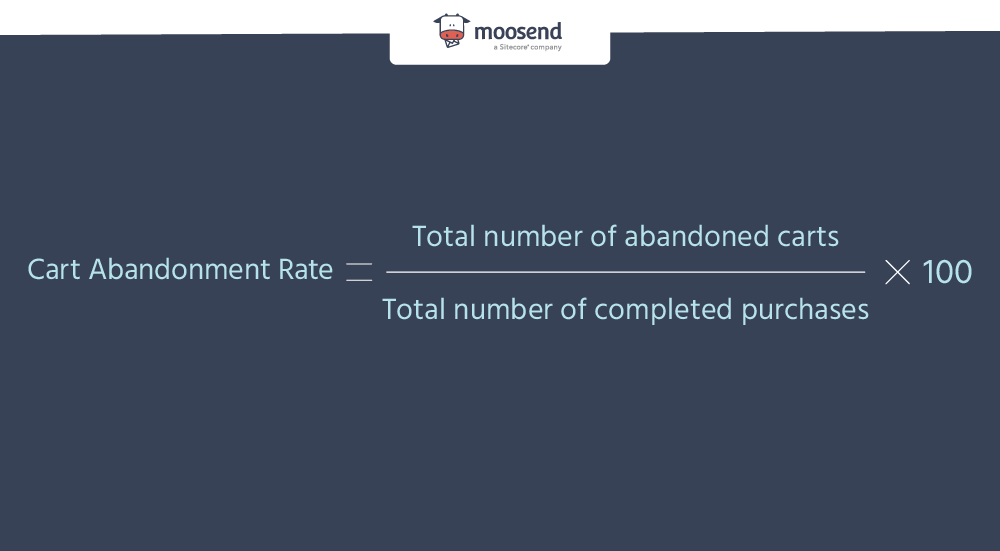
Wondering if your rate is high? Let’s see some key cart abandonment stats:
- According to the Baymard Institute, the average cart abandonment rate is 70.19%.
- High delivery costs, account creation request, and payment security are among the top cart abandonments reasons.
- The cart abandonment rate varies based on the industry you’re in, with Cruise & Ferry yielding the highest open rate compared to Consumer electronics and Groceries that have the lowest.
Overall, it’s a significant issue for online retailers, which can translate into lost sales and revenue. To recover them, marketers leverage certain strategies, such as improving the checkout and payment process or setting up cart abandonment emails.
Why People Abandon Their Online Shopping Carts
Let’s explore some of the most common reasons leading to cart abandonment:
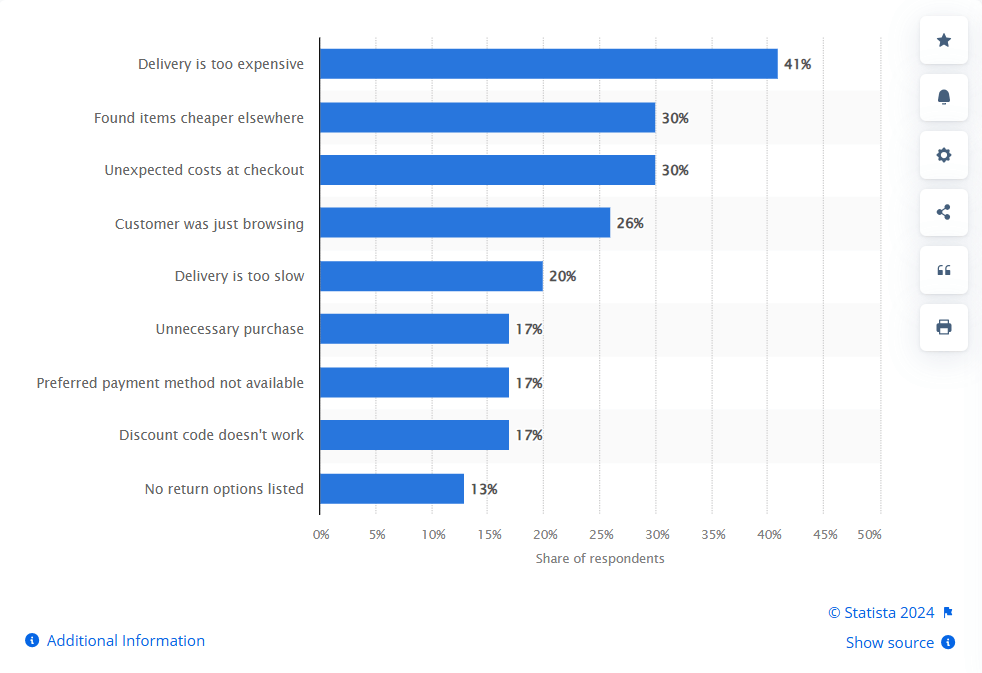
Expensive or slow delivery: Consumers drop off eCommerce sites with high delivery costs or long delivery times.
Competitive disadvantage: Some people are likely to leave their cart if they find a product or service at a better price or are offered incentives, such as coupons or discount codes.
Extra costs: Potential customers may abandon their carts if they land on extra or ambiguous costs they did not expect at first hand.
No buying intent: Some buyers add items to their cart spontaneously, without intending to buy any time soon.
Lack of payment options: Certain customers have preferred payment methods, such as PayPal or Klarna and drop off if they’re not available.
Website errors: Bugs and other website blockers throughout the customer journey can prevent potential customers from completing a purchase.
Mandatory account creation: Some customers, when requested to create an account from scratch, leave due to time constraints or because they’d prefer a guest checkout option.
Website security: Certain consumers withdraw from purchasing due to security concerns, especially with sites that look untrustworthy.
Checkout abandonment: A complex checkout flow with multiple steps or slow load times may disappoint potential consumers and push them away.
Insufficient return policy: When shopping from eCommerce businesses, consumers look for clear and generous return policies; otherwise, they might drop off.
Do you see yourself in any of those blockers? Get a quick fix to your cart abandonment issues with email marketing software like Moosend.
Sign up for an account, choose a premade abandoned cart template, and remind visitors they’ve left something behind with a relevant email. Just jump into the editor and set it up in simple steps.
How To Prevent Cart Abandonment
You can’t get rid of this revenue blocker with magic spells, but with the right tactics, you can make magic happen. Here’s how:
1. Optimize your checkout page
One of the first goals to set is simplifying the checkout experience of your eCommerce store. Reduce the number of required steps to complete a purchase and offer a guest payment method for people who prefer this option.
Including one-click checkout for registered members is a great idea to encourage easy or repeat purchases. So are auto-fill options that help customers move things faster. You can also use a progress bar to inform them how close they are to completing their order.
Another crucial step is to inform them about all costs upfront. Most consumers want to know how much they must pay in advance and get annoyed when they discover more costs later. Disclose costs such as shipping and taxes to help them evaluate their budget.
Here’s Zara Home’s guest checkout page. Its section stands out and valuable information, such as free shipping requirements and main payment options are available.
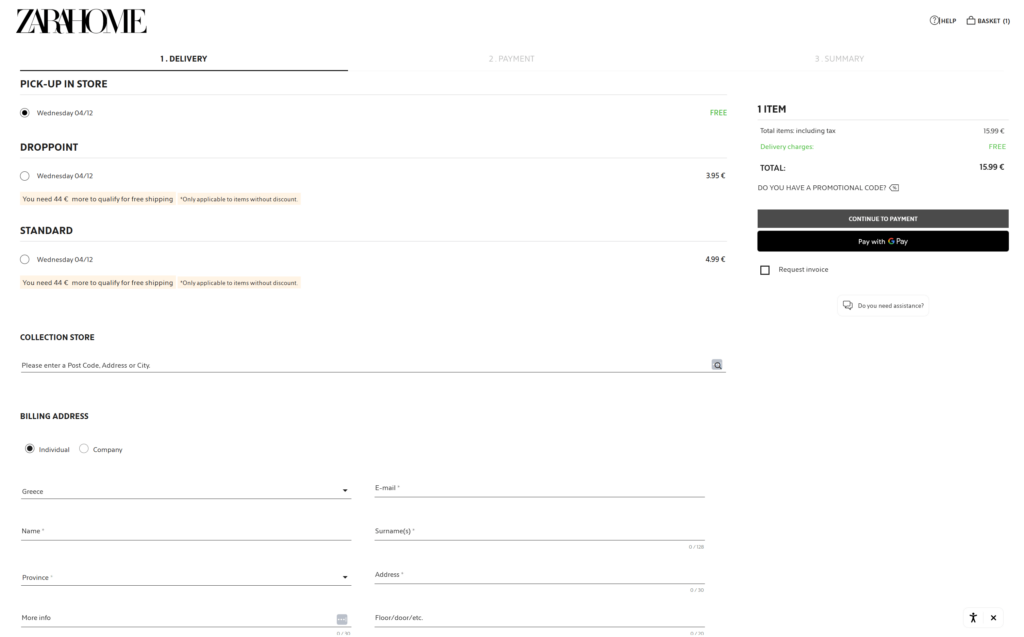
Many online shoppers start their checkout process on mobile devices, so offer a seamless experience there, too. Finally, add clear call-to-action buttons written in urgent language, such as “Buy now” and “Move to checkout” to make visitors convert faster.
2. Offer multiple payment and shipping options
Consumers usually opt for brands that offer various payment and shipping methods, enabling them to choose what’s best for them. So, apart from traditional payment means such as credit cards, provide them with more up-to-date ones like digital wallets.
This is also the case for shipping and returns. For instance, many shoppers prefer to pick up their purchases from physical stores or pick-up points due to busy schedules. It’s important to give them that choice.
Finally, be transparent about important policies, such as data and return, and make them easy to find and digest. Otherwise, if a customer has second thoughts about these options, they may drop off.
3. Build trust through security indicators
Would you complete a transaction from an eCommerce website that feels unsafe? You wouldn’t. Make your potential shoppers feel secure to increase completed transactions by following these steps:
- Use HTTPS encryption and display a padlock icon in the browser’s address bar.
- Share your privacy policy with customers and prospects with details about the measures you’re taking towards security.
- Add security badges to checkout and product pages to reduce hesitation.
- Share social proof, such as testimonials and star ratings to build more trust.
- Use a strong password policy and run regular audits to maximize security.
- Provide customers with FAQs and share your contact information and customer support options.
Overall, keeping a secure website and running regular technical and security audits will make even hesitant buyers give you a chance.
4. Use data-informed solutions
Reducing your cart abandonment and increasing your average order value requires a wealth of data. First, track your visitors’ behavior to name frequent drop-off points. Do they leave on the spot or during the checkout process? And how do they navigate your product and checkout pages?
Once you pinpoint some patterns, you can resort to A/B Testing. This is a go-to tactic for marketers who want to introduce something new without compromising customer experience and putting their revenue at risk.
In addition, remember that your customers are your biggest advocates. Send them a survey to collect important to perfect user experience. You can also send follow-up emails after a completed transaction while customers’ memory is still vivid and attuned.
Marketing Tips to Recover Abandoned Cart Lost Sales
Marketers have developed a few valuable techniques to tackle cart abandonment. After all, consumers who’ve put certain products in their basket are highly interested in buying and reminding them to do so can lower your shopping cart abandonment rate. Here’s how:
Abandoned cart emails
Abandoned cart emails help businesses nudge customers who’ve left items in their cart to claim them fast. It’s a rather cost-effective technique that receives high conversion rates when implemented correctly.
All you need to streamline it is an email automation software tool with user-friendly features. For instance, Moosend offers a premade automation workflow you can easily set up using an intuitive editor. You can choose a customizable abandoned cart template or build one from scratch with the beginner-friendly editor.
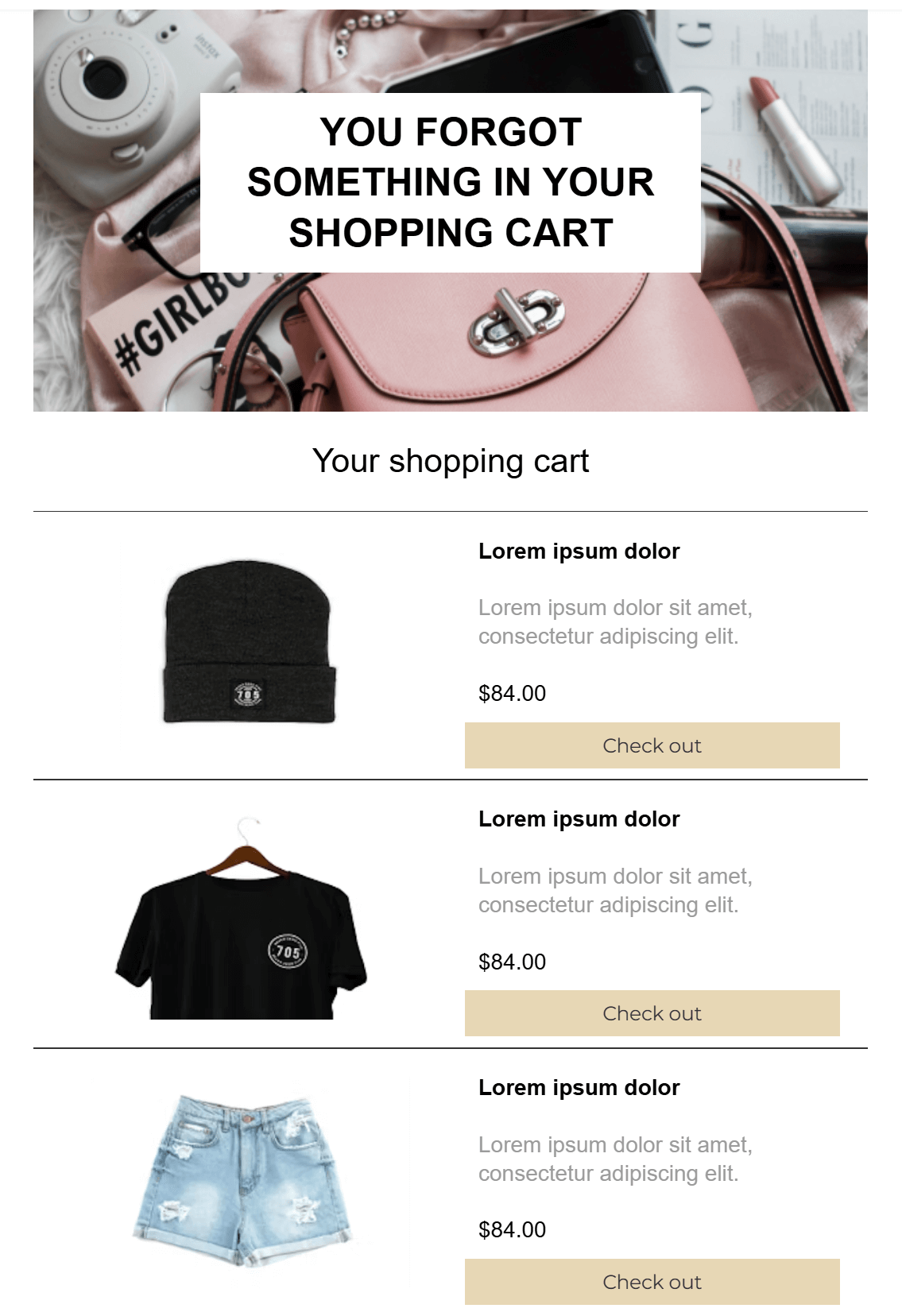
You can also create a follow-up sequence to maximize your conversion potential. Here are some tips to make these email campaigns successful:
- Write an attractive subject line reflecting the email’s purpose at first glance.
- Add high-quality product images and descriptions to grab the readers’ attention.
- Create clear call-to-action buttons to increase click-through rates and conversions.
- Utilize personalization techniques to make customers feel seen.
- Add social proof to reassure potential customers they’re in safe hands.
Here’s an amazing example by MOSCHINO:
Subject line: You left something behind
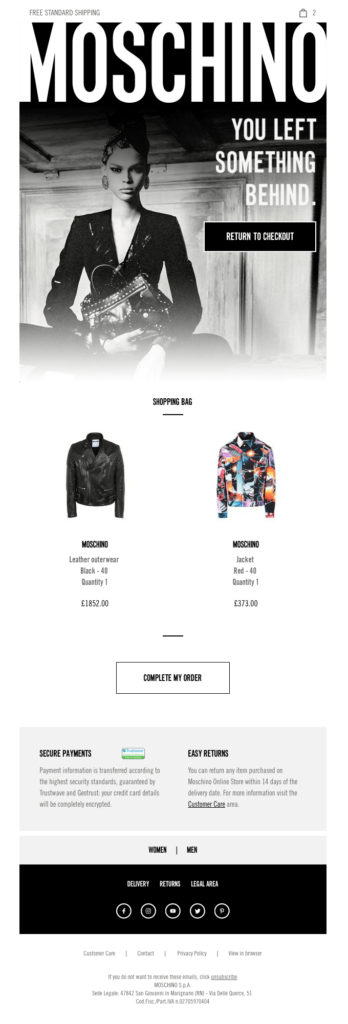
Retargeting ads
Another option for eCommerce sites with bigger budgets is running paid ads. Re-engage your audience while they search the web or scroll through social media to get them back to your website and convert them.
You can set them up on platforms such as Facebook Ads or AdRoll, installing a tracking pixel and targeting cart abandoners. Then, design clever and visually pleasing ads with converting copy. Add a sense of urgency to make it more compelling. For instance, “Limited Stock” is a great motivator.
Moreover, write a clear call-to-action to make them click-through your ad and finish what they started. And of course, learn where your audience usually hangs out to choose the right channels to convert them.
Kiss Cart Abandonment Goodbye
Now that you know what cart abandonment is and how to fix it, what will you try first? While you cannot zero it, you can use many straightforward techniques to alleviate it.
So, calculate your cart abandonment rate and find what suits you best to reduce it. And if setting up cart recovery emails is in your priority list, give Moosend a go. From customizable templates to personalization to sequences, we got you covered.
FAQs
Here are a few more cart abandonment-related questions and answers:
1. What is a good cart abandonment rate?
It’s typically within 60% to 75%, but it varies based on industry. If your rate is higher than that, you should take some recovery measures.
2. Why is shopping cart abandonment a problem for retailers?
Shopping cart abandonment can indicate a problematic purchase or checkout flow which can damage user experience and reduce the average order value. Sometimes, it happens due to security or quality concerns, too.
3. How can I improve my checkout process to reduce cart abandonment?
Here are some easy tactics to follow: 1) Minimize the numbers of steps needed to complete a transaction, 2) Use a guest payment method, 3) Offer different payment and shipping options, and 4) Follow high website security tactics.



 Published by
Published by

 Published by
Published by
